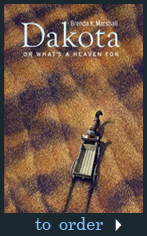Dakota, Or What’s a Heaven For: Thanks
Some people say that writing is lonely work. That has never been my experience, partly because I like being alone, partly because my characters keep me occupied in their fictional world, and partly because a number of individuals and organizations have kept me company at various stages of the writing process.
First off, let me just say that I love librarians. I love how much they love books, and how eager they are to track down and share information. So, you may not remember me, but if you directed me to a particular set of photographs, or gingerly handed me the handwritten dictionary of Dakotan Sioux or the worn diary of a St. Paul businessman (complete with a lock of hair tucked inside), or answered an email asking for the population of this or that prairie town, thank you. I especially want to thank Susan Dingle, formerly at the State Archives & Historical Research Library Division of the North Dakota Historical Society, and John Bye, John Hallberg and Michael Robinson at the North Dakota Institute for Regional Studies archives. Minnesota Historical Society Curator Linda McShannock generously spent a couple of hours with me in the vaults of the MHS showing me clothes from the period.
Institutions are harder to love than librarians, but a number of programs at the University of Michigan have given me crucial support. The Center for Research on Teaching and Learning awarded me grants in 2002 and 2010 to support travel for this project. The Rackham Graduate School First-Year Graduate Student Summer Funding program made it possible for me to work with a research assistant, Catharine Borden, in 2005. (Thanks, Catherine, for tracking down train timetables, pictures of ladies’ hats, advertisements for stoves and horse harnesses, and hundreds of other small details.)
And a big shout-out goes to the Institute for Research on Women and Gender for a seed grant in support of the production and marketing of Dakota, or What’s a Heaven For.
My literary agent, Jean Naggar, has been steadily pulling in the traces next to me, and is much appreciated.
The folks at the North Dakota Institute for Regional Studies Press have been a pleasure to work with. Thanks, especially to former Director of the Institute, Tom Riley, and to Ross Collins, Nancy Nelson, and Deb Tanner.
Several of my characters speak Norwegian. I don’t. Thanks to Anne Siri Sovdeas, Helen Muirhead, and Marion Vigen for translating help. For Jack Shaw’s Yiddish-inflected English, thanks to Anita Norich.
Finally, many thanks to Deborah Gibson for website design and construction (and generosity and patience).


